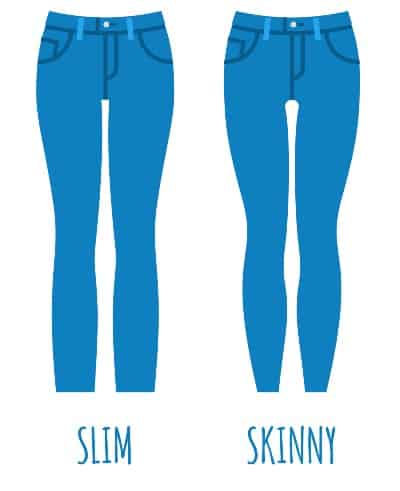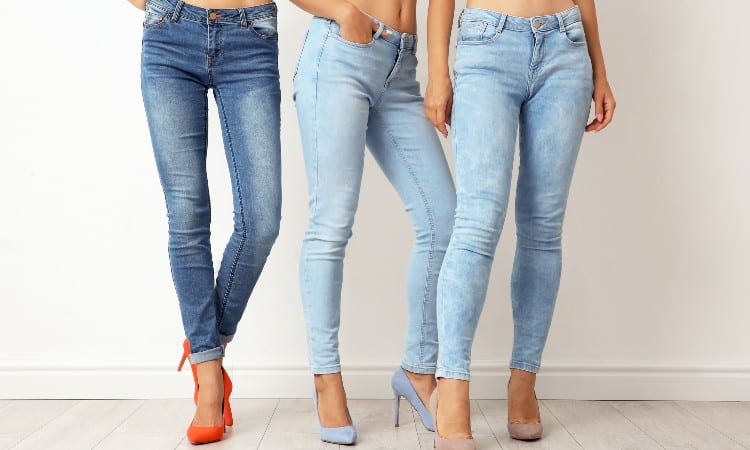When you need to buy a new shirt or a pair of jeans, you have to decide what type of fabric you like, what color you want, and what fit looks best on you! Every fit has a slightly different shape, with a narrow or full silhouette and a tight or loose style. This seems like a lot of work, but learning the key differences between skinny fit vs. slim fit will help you select shirts, pants, and even suits that fit you perfectly!
Skinny fit has a narrow, close-fitting cut in the shoulders, waist, and hips, and may incorporate elastic fibers to create skin-hugging material. Slim fit often has a straight but narrow cut and feels looser than a skinny fit style. In jeans, chinos, shirts and suits, skinny fit usually hugs the body more closely than a slim fit.
In this article, you will learn exactly what skinny and slim fit look like. You will find out key differences between these two styles of suits, pants, and shirts. Finally, you will discover helpful tips for selecting the perfect fit for you!

Skinny Fit vs Slim Fit: Key Points
You can think of skinny fit as the tightest clothing style while slim fit falls somewhere between skinny and regular styles. Of course, every type of clothing has its own unique cut as well. Take a look at this chart to get a quick overview of the key differences you can expect to find between skinny and slim-fit clothing.
| Jeans /Pants/Shirts Fit | Skinny | Slim |
|---|---|---|
| Leg or Arm Opening | Small opening, often constricts movement | Smaller opening than in a regular fit, but wider than in skinny fit |
| Cut | Most narrow of all cuts | Close-fitting but looser than skinny fit |
| Tightness Around Thighs | Very tight, clinging to legs from seat to ankles | Less tight from thighs to knees, but tapering at ankles |
| Rise | ||
| Side Seams | Usually tapered in shirts and jackets | Tapered in shirts and jackets |
| Type of Material | Usually, a stretch fabric blend containing elastic fibers | May use stretch fabric, may not |
| Body Type | People of all body types look great in skinny jeans, though slender people may find they look too tall without a loose shirt to balance the look. | People with hourglass or athletic builds tend to look better in slim-fit clothing. |
What is Skinny Fit?
 Skinny fit usually describes the most narrow, close-fitting style available for jeans, a shirt, or a suit. You may find some variations based on brand or type of clothing, but “skinny” always means a tight form of clothing.
Skinny fit usually describes the most narrow, close-fitting style available for jeans, a shirt, or a suit. You may find some variations based on brand or type of clothing, but “skinny” always means a tight form of clothing.
Skinny-style clothes often have legholes or armholes with a smaller circumference than other styles.
In some clothes like jeans, skinny fit almost always includes some elastic fibers in the material to make the tight cut stretch comfortably around your body. Because of the super-narrow style, you wouldn’t be able to move without the elastic!
The body-hugging style of skinny fit highlights certain elements of your shape. If you wear skinny jeans, your legs look longer and more clearly defined. If you wear a skinny-cut dress shirt, your silhouette or shoulders will look more defined.
Where did this tight-fitting style come from? Well, most sculpting or skintight garments rose to popularity because of fashion crazes in the 1980s. This era embraced the concept of skinny jeans, thanks to rockstars who made the style iconic as a symbol of changing culture and rebellion.
The 1980s also saw the development of the first stretch fabrics, which made this type of clothing possible! Synthetic fabrics like polyester and nylon were invented much earlier, around WWII. However, the concept of blending elastane or spandex into the material didn’t hit the market until the 1980s, when it appeared in swimwear and then in things like skinny jeans.
In the 80s, like today, not everyone embraced this facet of the fashion world. Though skinny fit clothing remains extremely popular, this cut does not look great on every single person. Even if you look fantastic in skinny jeans, you may look better in a less-tight shirt.
Plus, skinny-fit clothing tends to restrict movement. For this reason, this style doesn’t offer the most comfortable option, though it can certainly look cool!
What is Slim Fit?
 Slim fit style clothing fits sleekly around your body, giving it a flattering outline. This style usually has a looser fit than a skinny cut and does not restrict movement quite as much. This style features a cut that fits closely to your body but does not hug your skin in a clinging, elastic manner like a skinny fit.
Slim fit style clothing fits sleekly around your body, giving it a flattering outline. This style usually has a looser fit than a skinny cut and does not restrict movement quite as much. This style features a cut that fits closely to your body but does not hug your skin in a clinging, elastic manner like a skinny fit.
For example, slim-fit dress pants have narrow, tapered legs. Despite that, they offer wider leg holes and a little more fabric between the legs, giving you more ease of movement. They also usually don’t cling to your hips and thighs.
That said, a slim fit gives you a much sharper silhouette than a regular fit. A slim-fit shirt will have a tapered waist and more shaped shoulders than a baggy, rectangular regular-fit button-down. It will also typically feature tapered sleeves but will have plenty of room in the armhole to let you lift your arms!
Slim-fit clothing has gone in and out of style multiple times through the past decades for both men and women. The 1920s saw an explosion of sleek, close-fitting suits for men and stylish flapper dresses for women. Then again, the 1940s saw high-waisted, pleated, baggy pants for men and lots of bulky-shouldered jackets for women!
Today, slim fit remains popular for certain types of clothing. You can pretty much always find a slim cut available in any popular suit brand, for example. Slim-fit offers one of the most flattering, classy, and trendy looks for suits and button-down shirts.
That said, it isn’t currently viewed as quite as “hot” or “in” as a skinny fit for items like jeans. If you want to wear a pair of heels, jeans, and a silk shirt to a party, you will want to wear skinny jeans to look fashionable!
You will ultimately want to decide whether slim fit or skinny fit looks best on you, though. Matching your body type to a flattering cut will make you look a thousand times better than wearing the latest fashion trend!
What Is the Difference Between Skinny Fit and Slim Fit?

The main difference between skinny fit and slim fit is that skinny fight clothes hug the body more tightly than slim-fit clothes. Slim fit provides a sharp silhouette but does not usually cling to the contours of your body as skinny fit does.
Every type of clothing has slight differences in skinny and slim fit cuts, however. A skinny-fit shirt means something quite different from skinny-fit jeans!
Which is Tighter, Slim or Skinny Fit?
Skinny fit is usually the tightest style of clothing available, though slim-fit clothes will also outline the shape of your body without a lot of excess fabric draping off of you. SKinny fit styles usually contain less fabric than slim fit, though slim fit also offers a close-fitting style.
In terms of feel, you should expect skinny fit clothes to feel tight. The leg holes and armholes may feel constraining, and your arms, chest, waist, and thighs should feel a bit like a rubber band has wrapped around them when you wear skinny-fit clothes.
Slim fit clothes, in contrast, will rest against your body’s shape without pinching it. Armholes and legholes will offer more range of movement. Sleeves and pant legs will taper at the bottom but will not wrap around your arms and legs super-tightly.
All that said, you may not find a huge difference in measurement between the two styles. Some styles of jeans show only a 5% disparity between the size of the legs in their skinny and slim cuts, for example. The key is that that tiny 5% of fabric makes a big difference in how closely the fabric hugs your skin!
Suits
 The biggest difference between a skinny fit and a slim fit suit is that a skinny cut has a tighter fit in the armholes, shoulders, and legs than a slim fit. Most of the time, a slim-fit cut will provide more of a classic, elegant style, while a skinny fit will look hip and sleek.
The biggest difference between a skinny fit and a slim fit suit is that a skinny cut has a tighter fit in the armholes, shoulders, and legs than a slim fit. Most of the time, a slim-fit cut will provide more of a classic, elegant style, while a skinny fit will look hip and sleek.
A skinny-fit suit sometimes uses blended fabric that contains elastic and sometimes does not. The jacket on a skinny-fit suit usually has a shorter length than a classically styled suit. The pants will have narrow, tapered legs and contain smaller legholes to provide an even sleeker shape.
A slim-fit suit will feature narrow shoulders in the jacket and narrow, tapered legs in the pants. It will present what you might think of as the “classic” silhouette. Typically, trousers will break at the top of the shoe–the pant legs will not rest tightly against your ankle.
Tall or slender people often look best in slim-fit suits, as the narrow cut enhances a slender silhouette.
If you’re in the market for a streamlined suit, you should note that some brands may employ different terminology. For example, you might see descriptions like “ultra-skinny” or “classic close-fitting.”
You should also keep an eye on what kind of fabric the suit uses. For some brands, using fabric blended with elastic makes an item skinny fit rather than a slim fit.
Jeans
 The most prominent distinction between skinny fit and slim fit jeans is that skinny fit jeans fit more tightly in the hips and thighs than slim-fit jeans. Skinny jeans also almost always contain a percentage of elastic fibers to give them a rubber-bandlike stretch around your frame, while slim-fit jeans may fall in a straight line and not require stretchiness.
The most prominent distinction between skinny fit and slim fit jeans is that skinny fit jeans fit more tightly in the hips and thighs than slim-fit jeans. Skinny jeans also almost always contain a percentage of elastic fibers to give them a rubber-bandlike stretch around your frame, while slim-fit jeans may fall in a straight line and not require stretchiness.
Skinny jeans often use something called a four-way stretch fabric, so you don’t feel like your legs are shackled together while wearing these tight pants! Four-way stretch fabric can stretch and then recoil into its original shape both horizontally and vertically.
So, how tight are slim-fit jeans? Some slim-fit jeans may also use stretch material. In general, though, slim-fit jeans have a lot more fabric around the hips and between the legs to allow free movement.
Slim-fit jeans do typically have narrow legs, often tapering at the ankle. They also have a narrow waist and will not bag out in the seat area.
Now, that said, this distinction may not hold true across every brand. These generalities describe most jeans, most of the time. You will want to make sure you try on both cuts from a particular brand, though, before you make a purchase!
What you can count on is that every brand classifies its style of skinny fit as skinnier in some way than the slim-fit style sold by that brand.
Shirts
 A slim-fit dress shirt generally features tapered or inwardly curved side seams and a narrow chest and shoulder area, while a skinny-fit button-down will have high armholes, small sleeves, and usually a shorter length to suit someone with a skinny frame.
A slim-fit dress shirt generally features tapered or inwardly curved side seams and a narrow chest and shoulder area, while a skinny-fit button-down will have high armholes, small sleeves, and usually a shorter length to suit someone with a skinny frame.
Both styles offer a sharp, fitted cut designed to outline your shape without any extra, loose material.
In contrast, a regular-cut or classic style button-down usually has a boxy, rectangular shape and loose sleeves either pleated or gathered for added fullness.
Now, there’s nothing wrong with a classic or regular style button-down! In women’s fashion, wearing a loose blue that poofs out and then tucks in at the waist is quite trendy right now. But sometimes, you just can’t beat that smooth line of a fitted shirt tucking neatly into your waistband, either!
In menswear, you may find different terminology used to describe fitted dress shirts. For example, some brands offer both a slim-fit and a muscle-fit shirt rather than a skinny fit.
Chinos
 Chinos come in a slim fit more often than a skinny fit, though you can find both styles from some brands. Like jeans, these different cuts will vary a little from brand to brand, but slim fit typically falls somewhere between the regular style and the skinny style in terms of tightness.
Chinos come in a slim fit more often than a skinny fit, though you can find both styles from some brands. Like jeans, these different cuts will vary a little from brand to brand, but slim fit typically falls somewhere between the regular style and the skinny style in terms of tightness.
When you think of chinos, you probably picture loose khaki trousers ideal for casual wear or a low-key day at the office. While the classic, straight cut remains popular, you can also find a more streamlined style from certain brands today. The slim fit is the most popular, as chinos don’t typically feature stretch fabric.
This means that a skinny-fit pair of chinos could feel very constricting! As this style of close-fitting chinos gains in popularity though, you can expect to see more stretchable skinny chinos from more brands.
For now, check out the type of fabric blend used before making a purchase!
Are Skinny Jeans Going Out of Style?

It’s unlikely that skinny jeans will go out of style in the near future, though many other styles of denim certainly give the skinny jean some stiff competition! Denim fads come and go every year, leading some fashion experts to announce that trendier jeans have replaced skinny jeans. That said, plenty of fashion leaders and top brands continue to market skinny jeans, which have remained popular since the 1980s!
It’s true that you will always find a hot new craze in the world of jeans. You may spot jeans with cut-out pockets, jeans with patches sewn all over them, or jeans that seem like a handful of denim threads barely holding together around all the ragged holes! Plus, styles like bootcut or high waist jeans rise and fall in popularity, too.
All of that is to say that you should embrace many different styles of jeans if that makes you happy. But don’t expect the classics, like regular fit and skinny fit, to disappear any time soon!
Slim Fit Vs Skinny Fit Vs Tapered Vs Regular

The main difference between slim fit, skinny fit, tapered fit, and regular fit is the tightness of the garment and the way the arms or legs narrow in toward the wrist or ankle. Some types of clothing, especially pants, use various styles, including slim, skinny, tapered, or regular fit.
For pants, the defining difference between most cuts is the width of the pant leg. Skinny pants always have the least width, while a regular cut will offer the greatest width.
In other types of clothing, you can think of these styles as offering a shape that fits more or less closely to your body. Skinny style loathing will hug your skin whether you wear skinny jeans, a skinny-style suit, or any other form of “skinny” clothes!
A regular or classic cut traditionally offers a looser or boxier shape that includes plenty of extra fabric. For most brands, the regular fit will give you the roomiest, baggiest option.
Slim fit and tapered fit sometimes mean the same thing. Both styles almost always present arms or legs that are wider at the top and narrow at the wrist or ankles. For shirts and jackets, a slim or tapered fit typically has side seams that curve inward, creating a closer fit.
As with every special style, some brands may use these terms differently. Some brands may sell just a slim and a regular style of jeans, and other brands may offer a slim, skinny, and tapered style! The bottom line is that you have to do a little research and ideally try on multiple styles for each brand to see what looks best on you.
Difference Between Skinny and Slim Jeans Women’s

In women’s jeans, skinny fit still offers the tightest fit, but it may have a slightly looser ankle than the tapered cut of slim-fit women’s jeans. Most of the distinctions you read about earlier apply to women’s jeans and men’s jeans. Skinny always means the tightest, most elasticky kind of jeans any brand sells.
Slim-fit jeans will feel more comfortable because they often fit more loosely through the thighs and knees. This lets you move around much more easily than the clinging embrace of skinny jeans!
Tips for Buying the Right Fit For You
To select the perfect fit for your body, you need to know your body shape, identify the style that looks best on that shape, and then pair that knowledge with your favorite fashions! Of course, you should always do you and wear whatever cut feels right to you. But these guidelines will give you an idea of what cuts tend to look most flattering for most bodies.
How would you describe the shape of your body? In the fashion world, you will see the terms pear-shaped, apple-shaped, hourglass-shaped, and slim/athletic shaped used a lot. What does this mean exactly?
- Pear-shaped describes a body with narrow hips, a wide waist, and a full seat.
- Apple-shaped indicates a body with broader shoulders than hips, sort of like an upside-down triangle.
- Hourglass-shaped typically means a body with curves and a well-defined waist. This term usually applies to women’s bodies, while the other terms may apply to any sex.
- A slender or athletic shape often means a more rectangular body shape.
While all fashion “rules” are more like guidelines that work in some but not all scenarios, these tips may help you match a particular cut or fit of clothing to your body shape.
Pear-shaped bodies often look great in dramatically colored fitted tops. These accentuate your more narrow shoulders. Jackets and shirts that end at either the waist or mid-thigh will draw attention away from the “bottom of the triangle” area of your shape. Slim fit and skinny pants may not flatter your figure, so go with boot cuts instead–they will flare out at the bottom, balancing your form!
Apple-shaped figures may prefer to style looser shirts and jackets rather than a slim or skinny fit. On the other hand, you will look awesome in skinny jeans or tight-fitting pants of any kind! You may especially like to pair these flattering skinny pants with a loose-fitting top in bold colors.
If you have an hourglass shape, you want to wear clothes that accentuate your waist whenever possible! This means that slim fit or even skinny-fit shirts and jackets will look good on you, as will peplum tops (for women). Skinny jeans will show off your curves and your waist, though you may want to go with high-waisted pants instead to emphasize your curves!
Last but not least, if you have a slender or athletic/rectangular shape, you will want to focus on more loosely fitted coats and jackets rather than a slim or skinny fit. But skinny or slim-fit jeans and trousers will both look good on you!
As a final note here, you do want to play up the strengths of your body type, but you also want to blend this with your own personal style. Make sure you find a way to use the colors, fabrics, and types of clothes that make you happy!
Conclusion
Skinny fit and slim fit both create a narrow, fitted silhouette that fits the shape of your body closely. Skinny fit is almost always the tightest and stretchiest version of a piece of clothing sold by any brand. Slim fit often has a narrow cut but may include tapered arms and legs as well.
In pants, slim fit typically indicates more width in the hips and thighs but tapering ankles, while skinny fit means a super tight or body-hugging leg and a straight ankle. In jackets and shirts, slim fit indicates tapering side seams and narrow shoulders, while skinny fit often means smaller armholes, a shorter length, and narrow shoulders.
Do you prefer slim fit or skinny fit clothing? Why do you think one style looks better than the other? Leave a comment below to let us know!